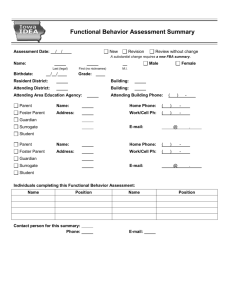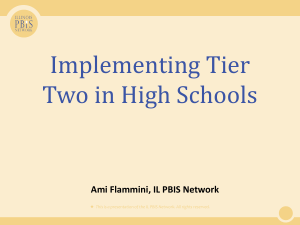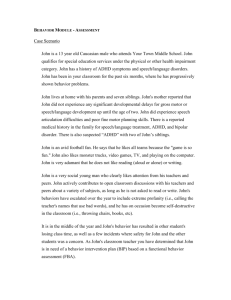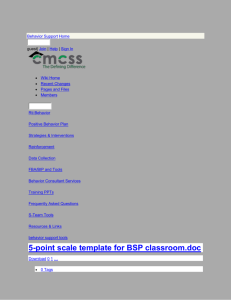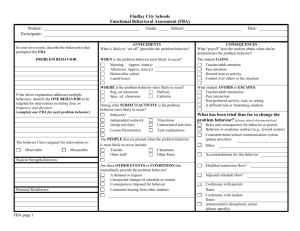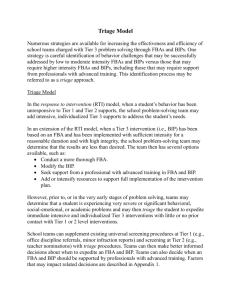Dodger R. Apple
advertisement
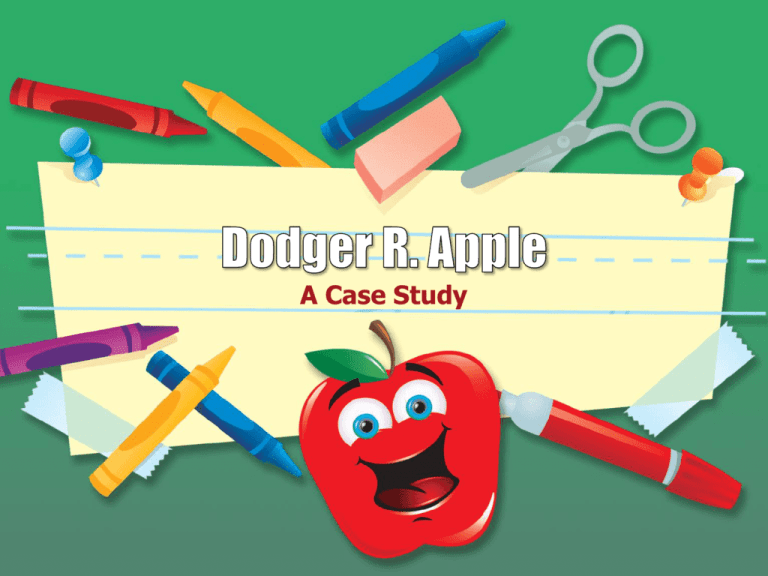
A Case Study What is PBIS? Positive Behavior Intervention and Support (www.pbis.org) Decision making framework to guide selection and implementation of best practices for improving academic /behavioral functioning Data-based, measurable outcomes, evidence-based practices, systems to support effective implementation 3-Tiered System of Support Necessary Conversations (Teams) Univers al Plans SW & Team class-wide supports Univers al Suppor t Selected Systems Uses process data; Team determines overall intervention effectiveness Problem Solving Team Standing team; uses FBA/BIP process for one youth at a time Intensive Systems Uses process data; Team determines overall intervention effectiveness CICO SAIG Brief Group w. individual feature FBA/BIP Brief FBA/BI P Comple x FBA/BI P WRAP Special Education Considerations What data do we need for EBD referral? Measure social, emotional & behavioral functioning and effects on 6 areas Severe, chronic, frequent behavior School and (home or community) Identify one of eight areas Observations Effects of prior interventions Exclusions & NEED FOR SPED - Special Education Considerations What data do we need for EBD referral? Need for Special Education 1. Needs cannot be met in reg ed as structured (unsustainable) 2. Modifications a. regular education enough b. special education needed 3. Other needs not met in reg ed Meet Dodger R. Apple Dodger was a happy student who loved school and had friends. Dodger’s teacher spent time using best practices: She taught school-wide and classroom expectations to fluency; She utilized a consistent classroom management system; She communicated frequently with his parents; She consistently practiced and retaught expectations when data suggested a need; She acknowledged appropriate behavior at a 4:1 ratio. Meet Dodger R. Apple Throughout school, however, Dodger: Difficulty staying on task Need for attention (teachers and peers) Difficulty respecting others’ personal space Physical and family concerns Behavior Data Attendance Excellent attendance ODRs None Behavior Screener Not yet used by the district Dodger’s Tier 1 Checklist What upset the apple cart? Family changes (March 2013) Resulting in: Struggled with staying on task and completing his work on time Disruptive in the classroom – yelling, crying, crumpling papers, etc. Wandered around the classroom without permission – hiding and leaving the classroom at times Argumentative Aggressive at times Noncompliance toward teacher directions As the year progresses: Attendance Continued to be excellent ODRs (4 weeks) Minors = 6 Majors = 1 AIMSweb Behavior Screener Completed December 2012 Screener results=72 (extremely elevated risk) Special Education Considerations What have we done thus far? Measured S/E/B functioning that “so departs from generally accepted, ageappropriate norms that it adversely effects classroom adjustment” Started “severe, chronic, frequent” Tier 1 strategies (interventions) “prior documented interventions” (done with fidelity and data) - DATA shows us where to go DES Tier 2 decision rules: 2 majors within 4 weeks, 5 minors within 4 weeks, Elevated risk on behavior screener, or Teacher or parent recommendation (Attendance and frequent visits to the nurse may also be added.) Based on this data, where do we move on the flowchart? 3-Tiered System of Support Necessary Conversations (Teams) Univers al Plans SW & Team class-wide supports Univers al Suppor t Selected Systems Uses process data; Team determines overall intervention effectiveness Problem Solving Team Standing team; uses FBA/BIP process for one youth at a time Intensive Systems Uses process data; Team determines overall intervention effectiveness CICO SAIG Brief Group w. individual feature FBA/BIP Brief FBA/BI P Comple x FBA/BI P WRAP A system of support for Dodger -CICO (Check In Check Out) start April 2 -Continued Tier 1 supports - 1 on 1 social skills coaching with the School Counselor Progress monitored for 8 weeks with regular checks of progress. 2013-2014 School Year Supports identified at the beginning of the school year: -CICO -Continued Tier 1 supports -Continued progress monitoring Special Education Considerations Need for SPED 2a. Are these sustainable in regular education? -What’s still missing? Chronic, severe (nonresponsive to SRBI), observation, 8 areas Problem-Solving Teams at DSD: Report out- What do PSTs look like at your school? Who participates? What does it look like? When do meetings occur? How do you track students? Important components of a PST -Operate as a PLC -Follow norms -Assign roles and responsibilities -Implement the plan -Check on the fidelity of the system and intervention TOOL: TIPS meeting format GUIDE FOR: Goal (including operational definition of problem behavior) Identified Solutions- Who? What? Where? When Implemented? Fidelity Plan changes along the way: Even though Dodger R. Apple is continuing to struggle, we’re not going to give up. After all, he is the apple of our eye. Special Education referral? Special Education Considerations Need for SPED 2b. Why would these need special education? -Frequent? Chronic? Severe? -Systematic observations? (FBA) Progress monitoring? Specialized instruction? …ALWAYS the apple of our eye GOALS: - 80% safe, respectful, and responsible daily (monitored by Daily Behavior Report/CICO) Writing goal aligned with CCSS (monitored by AIMSweb) SPECIALIZED INSTRUCTION: - Reteach and practice coping strategies - Co-taught classroom for language arts - Daily foreshadowing Our system of support- BIP Our system of support Our system of support CELEBRATIONS!
